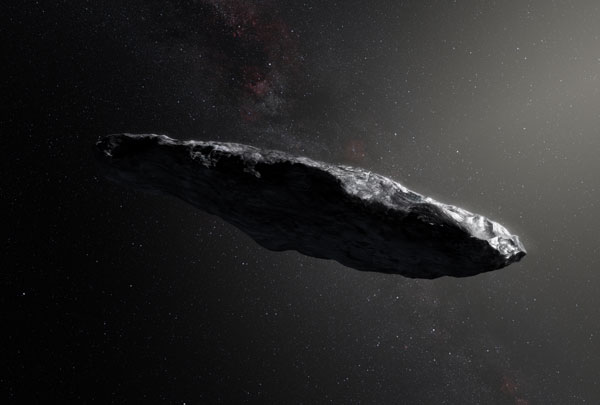It wasn’t aliens after all — an astrochemist and an astronomer have teamed up to explain why the interstellar object 1I/’Oumuamua behaved the way it did.

ESO / M. Kornmesser
An astrochemist and an astronomer may have just explained the unusual orbit of the interstellar visitor 1I/‘Oumuamua. They propose that it was emitting hydrogen picked up during its time between the stars, offering a relatively simple explanation to a puzzle that has previously prompted some outlandish claims.
The discovery of 'Oumuamua made headlines in 2017 because it was the first object ever observed to have entered our solar system from the wider universe. Its true nature wasn’t immediately obvious. Although initially classified as a comet, it didn’t have a visible tail or coma, as comets do. It was also extremely elongated, resembling a cigar in shape.
One thing that did make it more comet-like was the way it was accelerating as it went away from the Sun. It slowed on its way out, but not in the way expected if only gravity were in play; something was creating a force counter to gravity. Except that the normal mechanism behind such non-gravitational acceleration didn't seem to fit. Comets are home to large quantities of water ice and as the Sun warms this ice, it’s ejected as jets of gas that act as mini-rocket boosters. However, besides the lack of observed coma or tail, 'Oumuamua was also too small to have captured sufficient solar energy to drive this kind of activity.
The conundrum led some to call on more unusual explanations, such as the idea that ‘Oumuamua was an alien spacecraft with actual rocket boosters. However, Jennifer Bergner (University of California, Berkeley) and Darryl Seligman (Cornell University) have just put forward a much more straightforward scenario. “We had all these stupid ideas... and it's just the most generic explanation,” Seligman says.
“A comet traveling through the interstellar medium [gets] cooked by cosmic radiation,” says Bergner. Cosmic rays penetrate tens of meters into the ice, converting up to a quarter of the water molecules (H2O) there into molecular hydrogen (H2). This trapped hydrogen is then released when the Sun warms the comet.
Bergner and Seligman found that the effect of this outgassing is normally negligible. “But because ‘Oumuamua was so small, we think that it actually produced sufficient force to power this acceleration,” Seligman explains. At the same time, the amount of ice released would have been small enough that astronomers on Earth wouldn’t have seen it. The duo published their findings in Nature.
Alan Fitzsimmons (Queen’s University Belfast), who was not involved in the research, is impressed. “It’s a nice piece of science,” he says. “It probably won’t settle all debate around this object, but it provides a coherent picture of ‘Oumuamua based on current knowledge, without resorting to exotic or even fanciful theories.”
If Bergner and Seligman are correct, it could help us to better understand the conditions in other solar systems. “The comets and asteroids in the solar system have arguably taught us more about planet formation than what we've learned from the actual planets in the solar system,” Seligman says. “I think that the interstellar comets could arguably tell us more about extrasolar planets than the extrasolar planets we are trying to get measurements of today.”
Fitzsimmons also thinks it could tell us more about our solar system. “This process should occur for small comets from our own Oort Cloud,” he says. “What’s needed is a closer look at small objects on very long period orbits, which may be possible in the coming era of the Rubin Observatory and Extremely Large Telescope.” With both facilities due to see first light in the next five years, we may not have to wait too long for answers.
 3
3









Comments
Rod
March 23, 2023 at 8:29 am
"The conundrum led some to call on more unusual explanations, such as the idea that ‘Oumuamua was an alien spacecraft with actual rocket boosters. However, Jennifer Bergner (University of California, Berkeley) and Darryl Seligman (Cornell University) have just put forward a much more straightforward scenario. “We had all these stupid ideas... and it's just the most generic explanation,” Seligman says."
Where is the fun in this new explanation? 🙂 E.T. buzzing by in a spaceship is much more fun 🙂 However, I like good science answers.
You must be logged in to post a comment.
Ludovicus
March 24, 2023 at 4:58 pm
Surely though, a spectroscopic check of the gasses emanating in the vicinity SHOULD have shown H2, or at least some of the "broken water" - OH ions, O2, etc. (?)
It's cute to speculate, but unless they have trace element/molecular fragment analyses, there's not too much credo to this other than it may be possible! Volatile ices outgassing would have thrust too. Likely more momentum per unit mass than the H2. Hmmm....
Certainly beats the "alien" theory! lol!
You must be logged in to post a comment.
misha17
March 29, 2023 at 11:33 pm
... except observers didn't see a coma or tail, which are the usual evidence of outgassing from volatile ices.
You must be logged in to post a comment.
You must be logged in to post a comment.